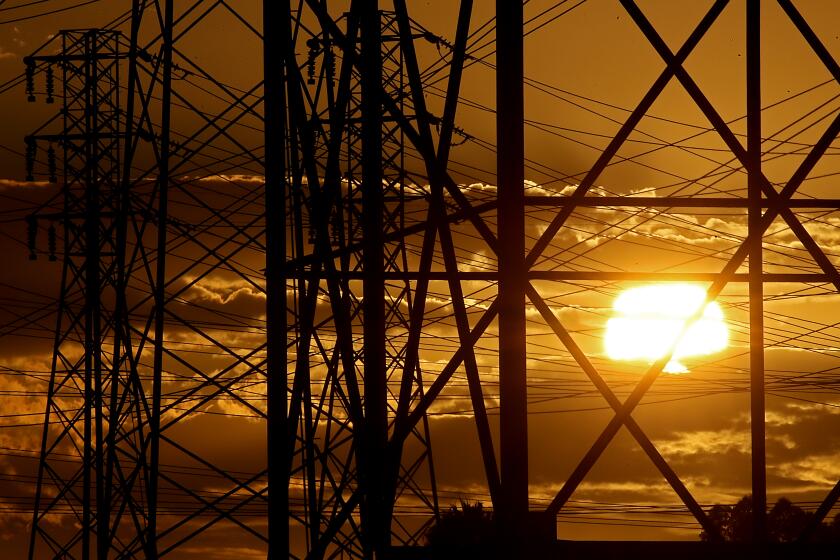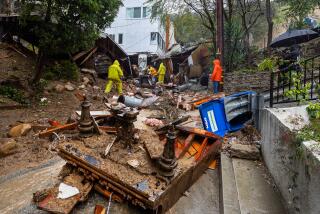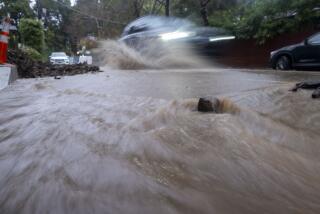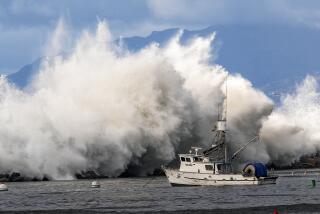Did you just get a flood warning? Here’s how to check your flood risk

As many Southern Californians were braving the storms Tuesday to cast their ballots, smartphones buzzed with an emergency alert from the National Weather Service: a flash flood warning for the east-central part of the county.
“This is a dangerous and life-threatening situation,” the warning stated. “Do not attempt to travel unless you are fleeing an area subject to flooding or under an evacuation order.”
The warning, which was aimed at Duarte residents, was set to expire at 4:45 p.m. Tuesday. But it’s not likely to be the only one we hear during what passes for a rainy season in Southern California. According to the California Department of Water Resources, the state experiences many types of flooding, including alluvial fan, riverine, coastal, flash and localized floods, as well as debris flows and tsunamis.
As their name suggests, flash floods can develop quickly, sometimes in just a few minutes and without visible signs of rain, according to Ready L.A. County.
Be aware of flood hazards wherever you live, but especially if your home is in a low-lying area, near water or near a recently burned hillside, Ready L.A. County advises.
Check the flood risk in your area
Use a flood map to understand the flood risk in your community and whether your home is in a flood zone.
A flood zone means the area has a potential for flooding during heavy rains or a weather disaster.
Two government agencies — the Federal Emergency Management Agency and the California Governor’s Office of Emergency Services — provide information online about flood risks and other hazards across California. All you have to do is plug your address into the search tool to see what issues your home faces.
On the FEMA map, moderate- to low-risk flood areas are labeled with the letters B, C and X. In these areas the risk of being flooded is reduced but not eliminated. High-risk flood areas are labeled with the letters A and V.
A community’s flood risk changes over time, so the National Food Insurance Program and the Federal Emergency Management Agency continuously work with communities across the country to identify and map flood risks.
Prepare for flooding
Preparing for a flood — or any kind of emergency situation, for that matter — starts with you making a plan with your immediate family and neighbors.
Part of that plan includes packing a go-bag that should have important documents (in a Ziplock or another type of waterproof bag), medication, an extra set of glasses (or contacts), a comfortable pair of shoes, a change of clothes, small bills (a number of $1 and $5 bills), a phone charger, flashlight, water and nonperishable food.
If you have pets, pack food, treats and an extra leash if you have one.
Keep in mind every family member’s needs when creating your go-bag.
Emily Montanez, associate director for L.A. County’s Office of Emergency Management, said you should try to create a small community of close neighbors to check in with when disaster strikes. Consider creating an emergency contact list on paper in the event your phone stops working or the battery dies and you can’t check the contacts there, she said.
Follow Emergency orders
If an evacuation is ordered or advised in your community, evacuate immediately.
Montanez said when it comes to safety, listen to first responders.
“If anyone receives a knock at their front door from someone in law enforcement or [from] the fire department, we definitely support taking the safest approach and evacuate your home,” she said.
Stay in the know about warnings and alerts by signing up with your local emergency mass notification system.
Be in the loop when disasters — like extreme heat or a hurricane this week, or earthquakes, tsunamis and wildfires at other times — are headed California’s way.
Los Angeles County residents can sign up with Alert L.A. County, Notify L.A. and Nixle to receive notifications via text message or email. Stay updated on weather forecasts by tuning in to your local news broadcast station and checking the National Weather Service Los Angeles office website.
If a flood warning or watch is issued for your community and you have some time before evacuating, relocate valuables (particularly water-sensitive ones, such as laptops, tablets and smart kitchen devices) from lower to upper floors. You should also disconnect all electrical appliances or turn off electric circuits at the fuse box or circuit breaker panel.
If you have been evacuated, wait until authorities give the all-clear to return to your home.
About The Times Utility Journalism Team
This article is from The Times’ Utility Journalism Team. Our mission is to be essential to the lives of Southern Californians by publishing information that solves problems, answers questions and helps with decision making. We serve audiences in and around Los Angeles — including current Times subscribers and diverse communities that haven’t historically had their needs met by our coverage.
How can we be useful to you and your community? Email utility (at) latimes.com or one of our journalists: Jon Healey, Ada Tseng, Jessica Roy and Karen Garcia.
More to Read
Sign up for Essential California
The most important California stories and recommendations in your inbox every morning.
You may occasionally receive promotional content from the Los Angeles Times.











